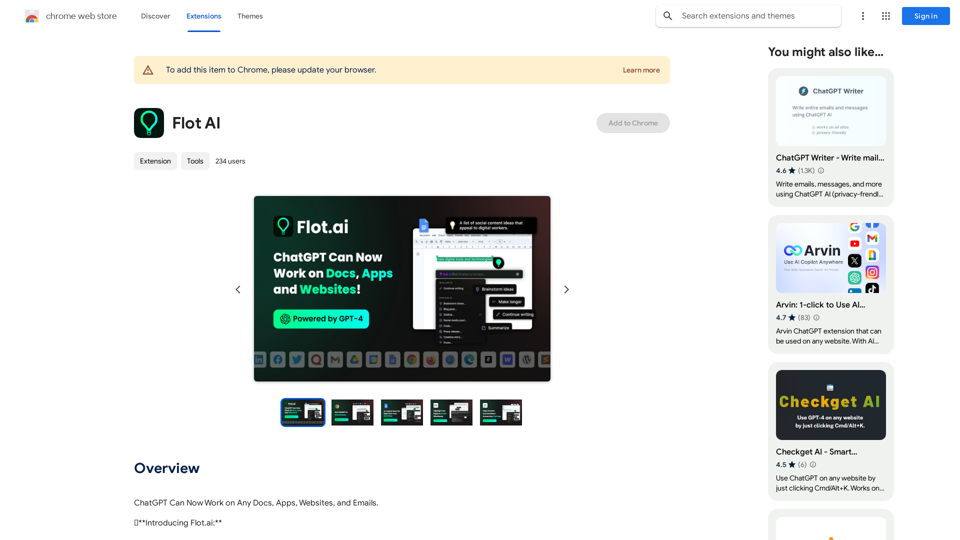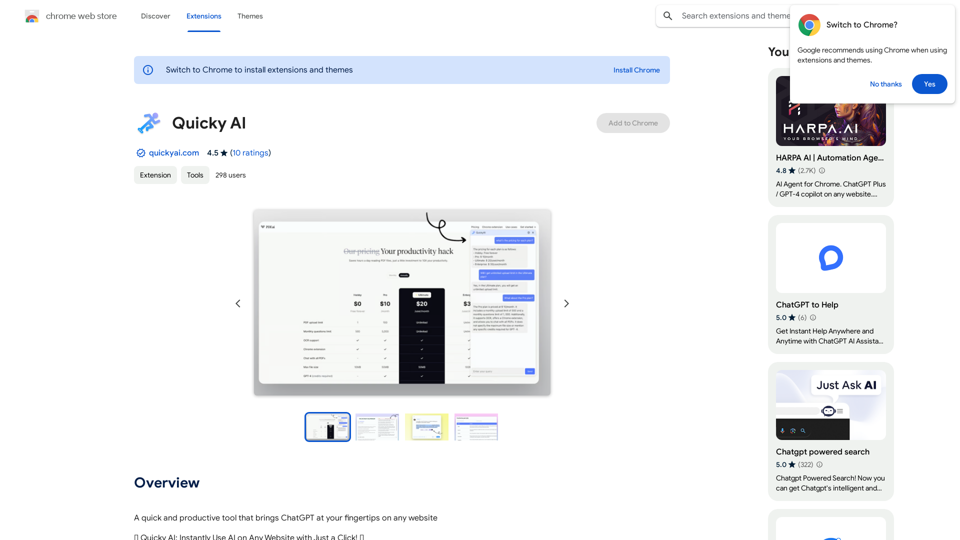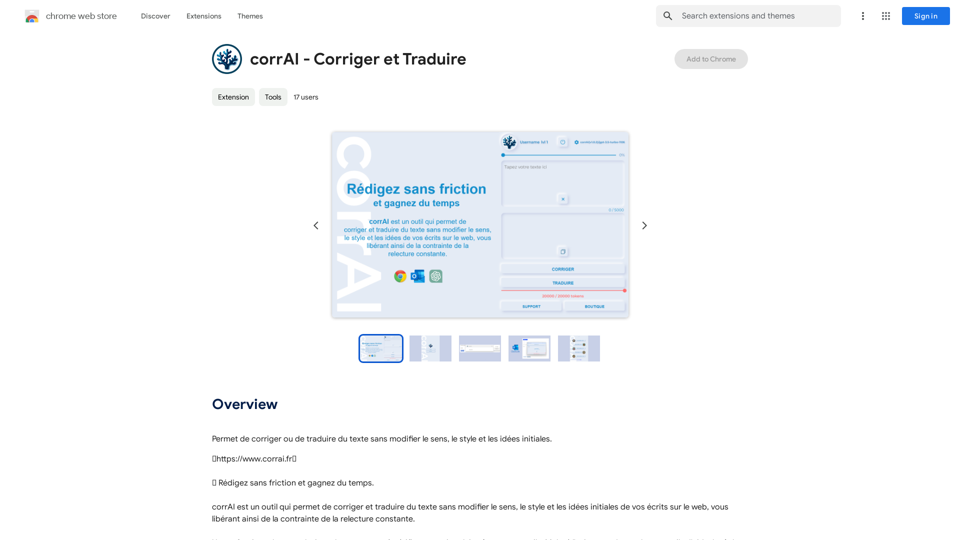The Chrome Web Store is a platform for discovering, installing, and managing extensions and themes for Google Chrome. It offers a wide range of add-ons to enhance browsing experience, improve productivity, and extend browser functionality. Users can explore categories, search for specific add-ons, or browse curated collections. The store also provides a developer dashboard for publishing and managing extensions.
Chrome Web Store
Enhance your browser with new features and customize your browsing experience.
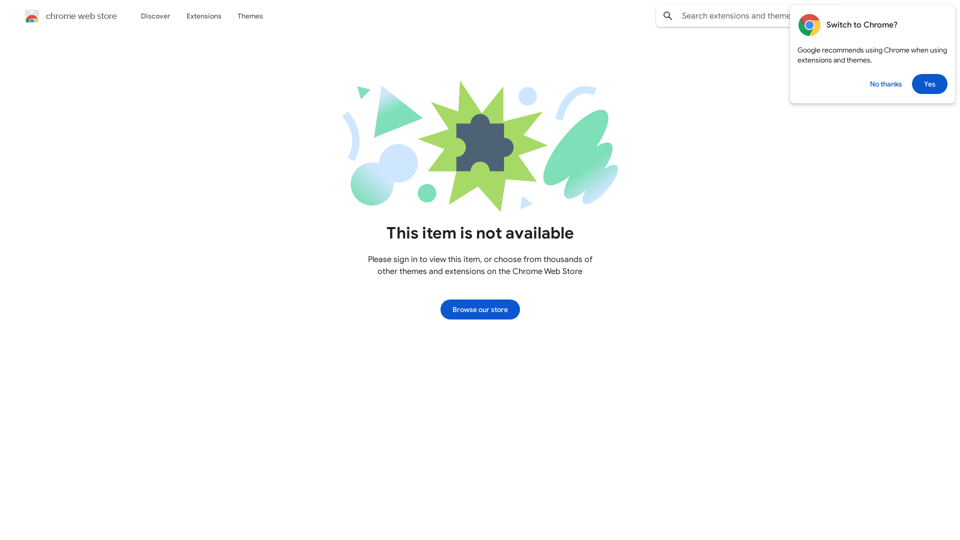
Introduction
Feature
Discover Extensions and Themes
- Browse through categories
- Search for specific add-ons
- Explore curated collections
- Vast array of extensions and themes available
Manage Extensions and Themes
- Update installed add-ons
- Disable or remove extensions
- Track usage and performance
Developer Dashboard
- Publish extensions and themes
- Manage published add-ons
- Track performance and user feedback
User-Friendly Interface
- Easy navigation and search functionality
- Clear categorization of add-ons
- Detailed information and reviews for each extension
Free Access
- No cost to use the Chrome Web Store
- Most extensions and themes are free
- Some premium options available for purchase or subscription
FAQ
How do I sign in to the Chrome Web Store?
Sign in with your Google account to access the Chrome Web Store.
How do I install an extension or theme?
Click the "Add to Chrome" button on the extension or theme page to install it.
How do I manage my installed extensions and themes?
Go to the Chrome Web Store, click on the "My extensions" tab, and manage your installed add-ons from there.
Are all extensions and themes free?
Most extensions and themes are free, but some premium options may require a subscription or one-time payment.
How can I ensure the safety of installed extensions?
- Read reviews and ratings before installing
- Be cautious with extensions from unknown developers
- Regularly check for updates to ensure security and proper functionality
Latest Traffic Insights
Monthly Visits
193.90 M
Bounce Rate
56.27%
Pages Per Visit
2.71
Time on Site(s)
115.91
Global Rank
-
Country Rank
-
Recent Visits
Traffic Sources
- Social Media:0.48%
- Paid Referrals:0.55%
- Email:0.15%
- Referrals:12.81%
- Search Engines:16.21%
- Direct:69.81%
Related Websites
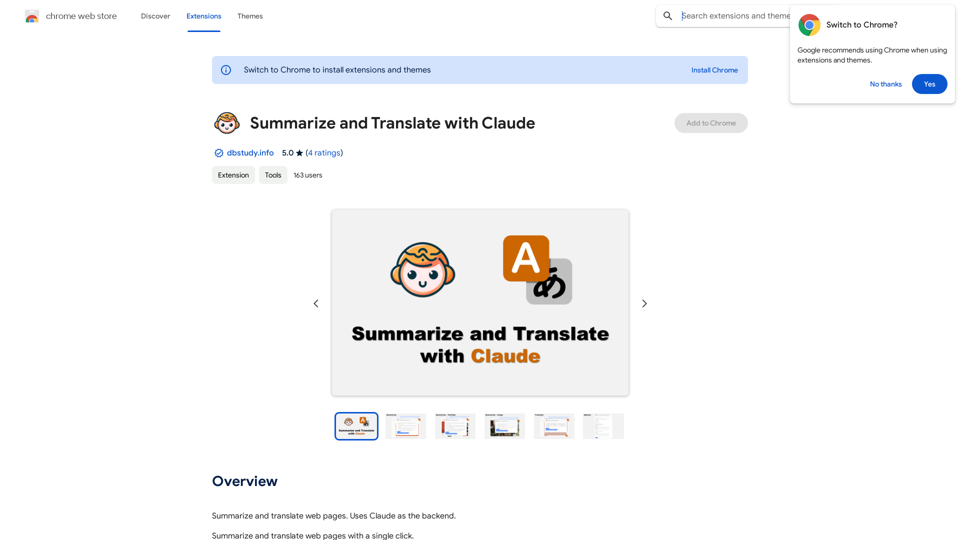
Please provide me with the text you'd like me to summarize and translate. I'm ready! 😊
Please provide me with the text you'd like me to summarize and translate. I'm ready! 😊I can help you with that! Just paste the web page URL here, and I'll use Claude's powerful abilities to: * Summarize the main points of the page in clear, concise language. * Translate the entire page into English for you. Let me know if you have a page you'd like me to work on!
193.90 M
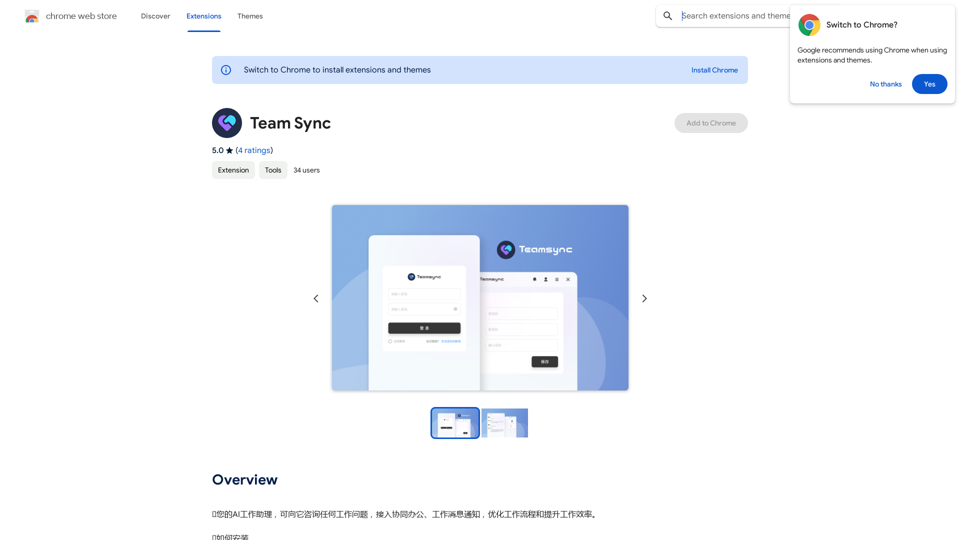
⭐ Your AI work assistant can answer any work questions you have. It integrates with collaborative work, work message notifications, to optimize your workflow and boost your productivity. ⭐ How to install Simply go to the Chrome Web Store, search for the extension, and click "Add to Chrome." Once installed, the extension will be available in your toolbar for easy access.
193.90 M
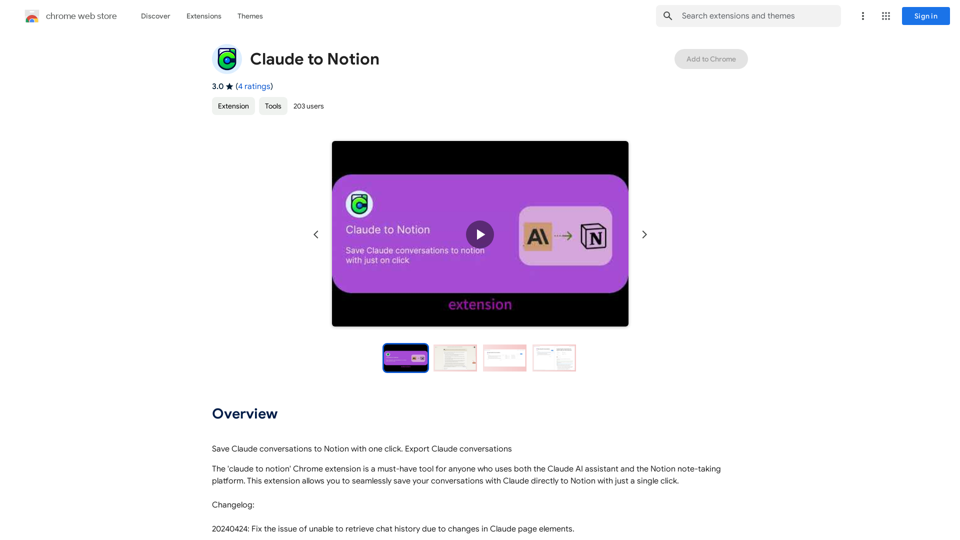
Claude to Notion This is a guide on how to connect Claude, an AI assistant, with Notion, a note-taking and workspace app. Why connect Claude and Notion? * Boost your productivity: Use Claude to generate content, summarize information, and automate tasks directly within Notion. * Enhance your research: Ask Claude questions about your Notion notes and get insightful answers. * Unlock new creative possibilities: Leverage Claude's generative capabilities to brainstorm ideas, write stories, or compose emails within your Notion workspace. How to connect Claude and Notion: 1. API Keys: Obtain an API key for both Claude and Notion. 2. Integration Tool: Explore integration tools like Zapier or Integromat to connect Claude and Notion. These platforms allow you to create workflows that trigger actions in one app based on events in the other. 3. Custom Development: For advanced users, you can develop your own custom integration using the Claude and Notion APIs. This gives you the most flexibility but requires coding knowledge. Example Use Cases: * Meeting Summarization: After a meeting, paste the transcript into Notion and use Claude to generate a concise summary. * Content Creation: Use Claude to write blog posts, articles, or social media captions directly within your Notion pages. * Idea Generation: Brainstorm new ideas for projects or tasks by prompting Claude with specific questions within your Notion workspace. Remember to review the documentation and terms of service for both Claude and Notion to ensure proper usage and security.
Claude to Notion This is a guide on how to connect Claude, an AI assistant, with Notion, a note-taking and workspace app. Why connect Claude and Notion? * Boost your productivity: Use Claude to generate content, summarize information, and automate tasks directly within Notion. * Enhance your research: Ask Claude questions about your Notion notes and get insightful answers. * Unlock new creative possibilities: Leverage Claude's generative capabilities to brainstorm ideas, write stories, or compose emails within your Notion workspace. How to connect Claude and Notion: 1. API Keys: Obtain an API key for both Claude and Notion. 2. Integration Tool: Explore integration tools like Zapier or Integromat to connect Claude and Notion. These platforms allow you to create workflows that trigger actions in one app based on events in the other. 3. Custom Development: For advanced users, you can develop your own custom integration using the Claude and Notion APIs. This gives you the most flexibility but requires coding knowledge. Example Use Cases: * Meeting Summarization: After a meeting, paste the transcript into Notion and use Claude to generate a concise summary. * Content Creation: Use Claude to write blog posts, articles, or social media captions directly within your Notion pages. * Idea Generation: Brainstorm new ideas for projects or tasks by prompting Claude with specific questions within your Notion workspace. Remember to review the documentation and terms of service for both Claude and Notion to ensure proper usage and security.Save Claude conversations to Notion with one click. Export Claude conversations.
193.90 M
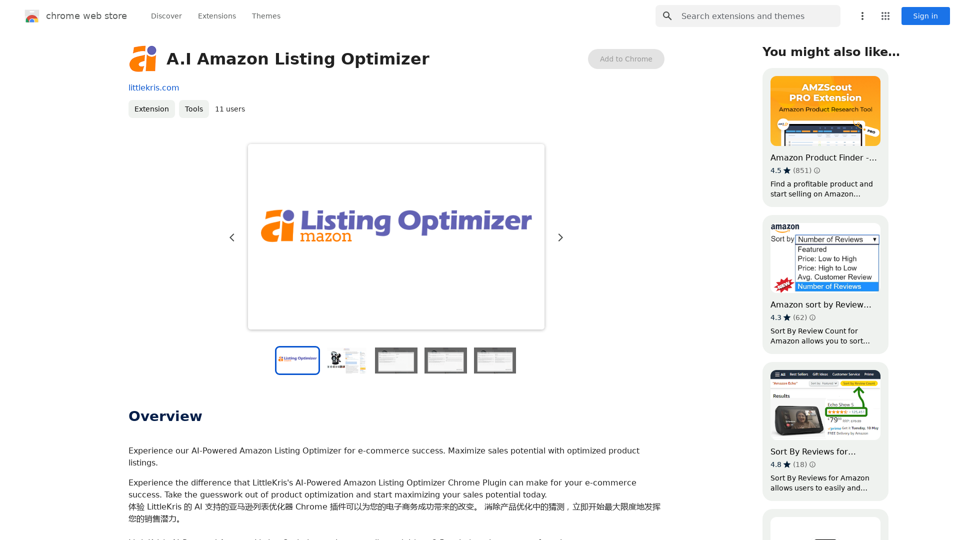
Experience our AI-Powered Amazon Listing Optimizer for e-commerce success. Maximize sales potential with optimized product listings.
193.90 M
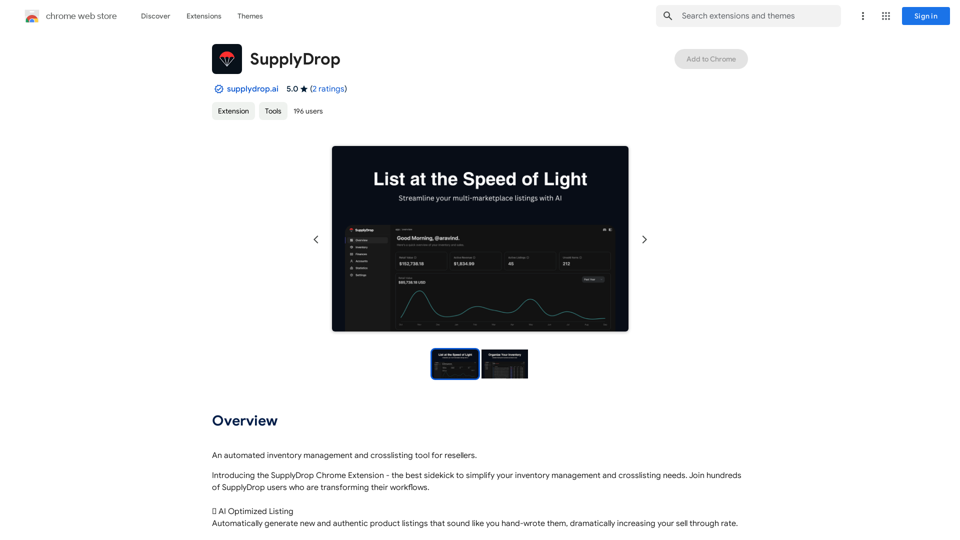
A tool that automatically manages inventory and lists products on multiple platforms for resellers.
193.90 M
